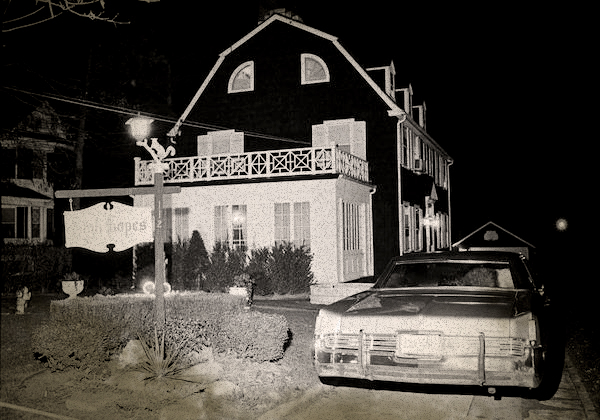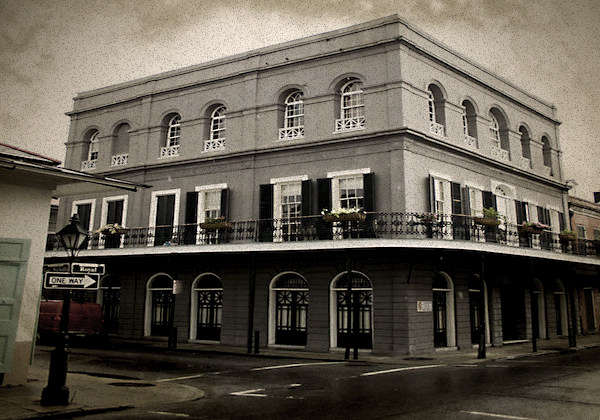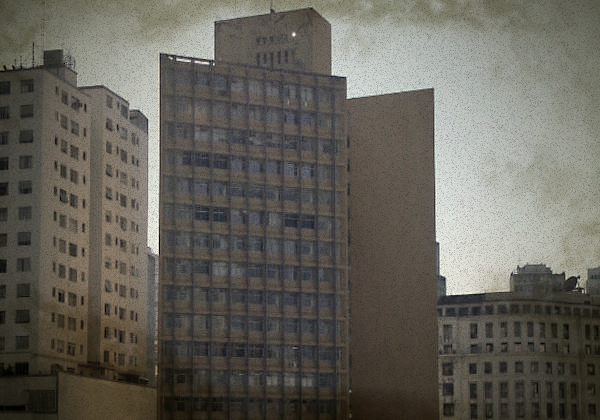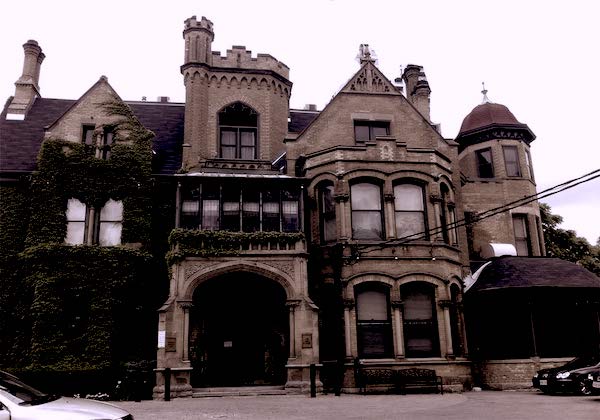
1. Garden Reach. Cheltenham, UK
Built in the 1860 decade. ‘Garden Reach’ was bought by Henry Swinhoe and wife Elisabeth Francis Higgins and they raised a family of five children. However, Elisabeth died and in 1870 Henry married again. His second wife was Imogen Hutchins, their relationship was marred by frequent quarrels, apparently over the upbringing of Swinhoe’s children as well as the possession of the former Mrs Swinhoe’s jewellery for which Henry had a secret hiding place fashioned under the drawing room floor. Henry and Imogen separated in 1876 – Henry lived on at ‘Garden Reach’ for a few months before dying in July of the same year.
Imogen died at Clifton in 1878 but was in fact buried at the Holy Trinity Church in Portland Street, Cheltenham, quite close to her former home. In March 1882 the tenancy on the building was taken by Captain Frederick W. Despard and his family. The Despards lived here for ten years, leaving in 1893. Rosina, one of Frederick's daughters, was the first witness of the appearance of the ghostly woman in black in the house two months after the Despards moved in. Rosina kept written records of the appearances (half a dozen times during 2 years) of the apparition in the form of letters to a friend, Miss Catherine Campbell, and from this correspondence the 1892 report in the SPR’s Journal was eventually compiled. Rosina described the apparition for the first time. One evening after retiring to her room she was disturbed by the sound of someone at the bedroom door: “ Going a few steps along the passage, I saw the figure of a tall lady, dressed in black, standing at the head of the stairs. After a few moments she descended the stairs, and I followed for a short distance, I had only a small piece of candle, and it suddenly burnt itself out; and being unable to see more, I went back to my room.” Rosina describes the figure as being dressed in soft woollen material holding a handkerchief up to its face so partly obscuring the features, with either a long veil or a hood giving the figure the aspect of being that of a woman in mourning. Rosina was not the only one to see the figure, also her sister Freda and a housemaid also saw a figure which she took to be an intruder, also his brother Wilfred Despard was on the terrace outside the drawing room with a playmate when both boys saw a woman in obvious distress standing near to the drawing room window. In 1884 an immediate neighbour General Annesley, corroborated the appearance of the figure, a lady whom he had seen crying in the orchard, which was visible from the road. Up until 1886 the figure was solid and lifelike and was often mistaken for that of a living person. The complete history of the house is known, and if we are to connect the figure with any of the previous occupants, she is the only person who in any way resembled the figure, the unfortunate Imogen Swinhoe who died three and a half years before the Despards moved in. The Society for Psychical Research made a study of the haunting and came to the conclusion that as well as the experiences of the Despards in the 1880s, there was evidence for the reappearance of the woman in black in the neighbourhood up until relatively recent times. Another incident took place in January 1970 when Cheltenham resident Mrs Jackson was having a driving lesson that took her past the gates of the house. She suddenly changed gear and began breaking sharply. She said she saw the figure of a tall woman wearing a long black dress had stepped off the pavement about twenty yards ahead into the path of the oncoming car. Another reported incident occurred in July 1985 when two witnesses, an Oxford University music graduate in his sixties and a friend, walking along Pitville Circus Road saw a tall woman dressed in black wearing a crinoline moving along the footpath of the house towards its junction with the main road.
Read more

2. Boleskine House. Foyers, UK
The parish of Boleskine was formed in the 13th Century. A Kirk and graveyard were built in the parish around this time. Minister Thomas Houston (1648–1705) was said to have had the task of hastily laying animated corpses back in their graves after a devious local wizard had raised the dead in Boleskine graveyard. Boleskine House was built on the site of the kirk, which, according to legend, caught fire during congregation and killed everyone inside. The house was constructed in the 1760s by Colonel Archibald Fraser as a hunting lodge.
Occultist Aleister Crowley purchased Boleskine House from the Fraser family in 1899. Crowley believed the location was ideal to sequester himself to perform a series of operations. Crowley became infamous for stories of conducting black magic and various other rituals while residing at the house. His lodge keeper, Hugh Gillies, suffered a number of personal tragedies, including the loss of two children. Crowley later claimed that his experiments with black magic had simply got out of hand. Crowley left the property in 1913. After the Second World War the house was owned by a Major Edward Grant. In 1965, Grant committed suicide in Crowley's bedroom with a shotgun. Jimmy Page bought the house in 1970 as a collector of Crowley memorabilia who was fascinated by his ideas. After arranging for the house to be restored he spent little time at Boleskine, leaving things in the care of his friend Malcolm Dent. When Dent moved into the house it was a wreck. There'd been at least one fire there. Although Dent was a sceptic of the paranormal he soon started to experience strange occurrences. After a few weeks, he heard strange rumblings from the hallway which stopped when he investigated, but resumed after he closed the bedroom door. Dent explains "above Boleskine there's a place called Errogie which is supposed to be the geographical centre of the Highlands. Boleskine was then the nearest consecrated ground to Errogie and it's thought his soul, or part of it, ended here.” Dent also experienced the "most terrifying night of my life" at Boleskine. He awoke one night to hear what sounded like a wild animal snorting and banging outside his bedroom door. It went on for some time and it was not until morning that Dent dared open the door, and there was nothing there. Another friend who stayed at Boleskine awoke one night claiming she had been attacked by "some kind of devil". Other occurrences, such as chairs switching places, doors slamming open and closed for no reason and carpets and rugs rolling up inexplicably. Since 1992 there have been several other private owners with no reported mysterious occurrences. Today the interior of the house was almost totally destroyed by 2 fires happening in 2015 and 2019. The ruins are now owned by the Boleskine House Foundation SCIO which plan to restore the house and gardens to their original form and then open the estate to the public.
Read more

3. Palazzo Dario. Venezia, Italy
One of the most beautiful buildings of Venezia’s Gran Canale, built (apparently) over the terrains of an old templary cemetery ground in gothic style restored in byzantines and renaissance elements. There are no ghost stories here, but the truth is that all inhabitants along the history of this building have died in strange circumstances. It is told that the first victim of the “house curse” was Marietta, the daughter of the initial builder, Darío Giovanni. Marieta died in 1515 stressed by debts and most absolute poverty after the death of her husband Vincenzo Barbaro, who stabbed himself. Even their son suffered a violent death, in fact he died in an ambush in Crete.
After this the house was owned by the Barbaro family, who lost their heirs murdered. Next on the list is marquis Arbit Abdoll en 1806, who lost all of his fortune right after buying the house and died in misery. The Englishman Radon Brown met his fate in 1838 when he became the new owner. In only four years he suffered a financial meltdown and his homosexual relationship was discovered: the scandal engulfed him so much that in 1842 he committed suicide in the palace together with his partner. In the early 1900s the Palazzo hosted the French poet Henri de Regnier; but a serious illness struck the writer, so he couldn’t come back to Venice anymore. For decades the building was empty, until 1964 when the tenor Mario del Monaco began the negotiations to buy the property. But the artist, on his way to Venice to finalize the details of the contract, was involved in a serious car accident that forced him to a long rehabilitation and made him decide to give up the purchase. A few years later was bought by Count Filippo Giordano delle Lanze, who was killed inside the building in 1970 by a Croatian sailor named Raul Blasich, with whom he had a relationship. Blasich then fled to London, where he was murdered. The palace was later bought by Kit Lambert, manager of the rock band The Who, who died a very short time later in London falling down stairs. Although he claims not to believe in the curse, Lambert had told some friends to sleep in the nearby Hotel Gritti gondoliers kiosk to “escape the ghosts that haunted him in the Palace”. Fabrizio Ferrari, a venetian businessman, bought the house in the 80s and moved there with his sister Nicoletta. Ferrari lost all of his assets after taking possession of the building, while his sister died in a car accident without witnesses. In the late 80s, the building was purchased by financier Raul Gardini. After the involvement in the scandal of Tangentopoli, committed suicide in 1993 in unclarified circumstances. After that no one wanted to buy the house anymore, and the first brokerage company that had been mandated to sell surrendered and stranded down. In 2002, a week after renting it for a vacation in Venice, bass player John Entwistle died because of a heart attack. In 2006 the property passed to an American company and it is currently being restored.
Read more

4. Palacio de Linares. Madrid, Spain
One of the buildings that attract the most historians, journalists and the curious. Psychophonies, mysterious images and dozens of stories talk about a child that runs around the corridors, stairs and salons looking for her mother. The building was built in the XIX century and inhabited by a business man Mateo de Murga and his son Jose. Story tells that Jose fell in love with the daughter of a cigarette seller and wanted to marry her, the father opposed that.
Jose waited until his father died to marry her, and later on he discovered that the young woman he had fallen in love was actually his father's illegitimate daughter. Jose went mad when he discovered this, he then rejected her, and they murdered Raimunda, the child they have had in common. Then it is said the corpse was hidden in a coffin behind a wall. Although history has obscured the truth about Raimunda, we do know for sure that after the death of the Marquises, the palace passed from owner to owner without ever being inhabited for long, due to the frequent paranormal events that occurred there. The years, decades and finally centuries passed, until in 1990 restoration works were taking place, an the strange events that continued to occur at the Palace of Linares became the focus of national attention. Some workmen claimed to have heard strange voices. Specialists came to study the case and reported to have experienced strange happenings within the walls of the palace: gusts of wind, the sound of a baby crying, organ music, wailing, moans and lamentations of women.
Read more
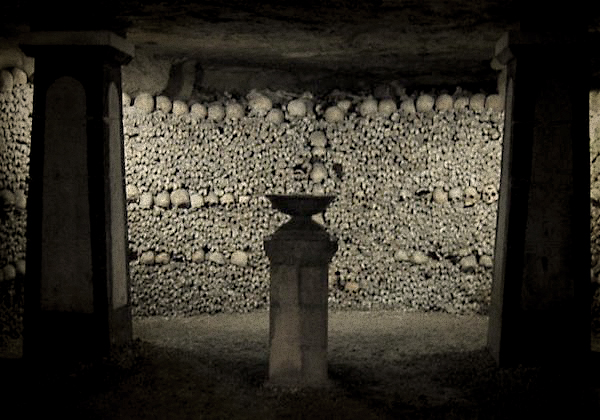
5. Catacombs of Paris. Paris, France
The Catacombs of Paris are underground ossuaries, which hold the remains of more than six million people in a small part of a tunnel network built to consolidate Paris' ancient stone quarries.
Extending south from the Barrière d'Enfer ("Gate of Hell") former city gate, this ossuary was created as part of the effort to eliminate the city's overflowing cemeteries. Preparation work began not long after a 1774 series of gruesome Saint Innocents-cemetery-quarter basement wall collapses added a sense of urgency to the cemetery-eliminating measure, and from 1786, nightly processions of covered wagons transferred remains from most of Paris' cemeteries to a mine shaft opened near the Rue de la Tombe-Issoire.
Read more
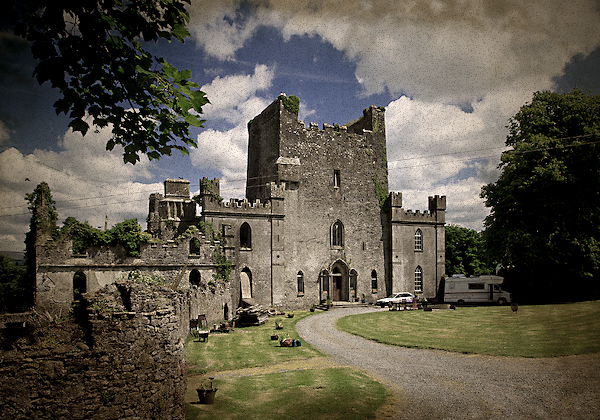
6. Leap Castle. Coolderry, Ireland
Constructed most likelyaround 1250 CE. by the O'Bannon clan that were the "secondary chieftains" of the territory and were subject to the ruling O'Carroll clan, eventually the O'Carrolls had gained possession. Following the death of Mulrooney O'Carroll in 1532, family struggles plagued the O'Carroll clan. A fierce rivalry for the leadership erupted within the family. The bitter fight for power turned brother against brother.
In 1659, the castle passed by marriage into the ownership of the Darby family. Séances were held in the castle by Mildred Darby who was a writer of Gothic novels: this led to publicity about the castle and its ghosts. A Red Lady ghost is reported to walk the halls holding a dagger. Two little girls named Charlotte and Emily are reported to run up and down the spiral staircase. Emily died after she fell from the battlements on the top of the castle’s tower and Charlotte can still be seen running around after her sister and calling her name. The castle is also allegedly haunted by a sinister elemental spirit referred to only as "It". The creature is described by Mildred Darby as being about the size of a sheep with a human face, black holes for eyes and a nose and giving off the smell of a rotting corpse. During renovation of the castle in the 1900s, workers found an oubliette behind a wall in the chapel. At the bottom of the shaft were many human skeletons amassed on wooden spikes. When cleaned out, it took three cartloads to remove the bones. It is believed that the O’Carrolls would drop guests through the trap door to be impaled on the spikes 8 feet below.
Read more
